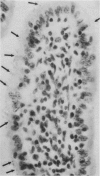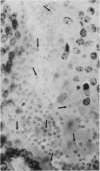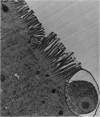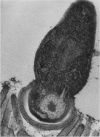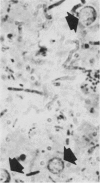Abstract
Cryptosporidia organisms were identified in 42 of 161 (26%) neonatal, diarrheic calves, over a 32 month period commencing July 1979. Forty of the 161 calves were submitted alive and cryptosporidiosis was diagnosed in 63% (25 of 40) of them. The cryptosporidia infected calves were usually one to two weeks old and came from 26 herds where the typical history was profuse, watery diarrhea in nearly all neonatal calves. The diarrhea usually started around one week of age, was unresponsive to all conventional antidiarrhea therapies, lasted for two or more weeks and was usually fatal. Twenty-nine (69%) of the cryptosporidia infected calves were submitted between December and February. These calves were often hutch reared.
Histopatholoical examination revealed large numbers of the coccidial parasite Cryptosporidium sp embedded in the microvilli of jejunal and ileal absorptive enterocytes of all affected calves. The organisms were identified as trophozoites and schizonts (asexual stages) and macrogametes (female sexual stages) with the electron microscope. Microgametes (male sexual stages) were not identified. Occasionally a merozoite (asexual stage) was also seen apparently burrowing into or about to be enveloped by a host microvillus. Observation of the organisms was much easier when diarrheic calves were submitted alive. Enterotoxigenic Escherichia coli were often cultured from intestines of dead calves and occasionally from calves submitted alive. Coronavirus particles were seen in one calf. In the last year of this study, oocysts were identified in fecal smears stained with May-Grünwald-Giemsa stain and fecal samples using a dichromate solution flotation technique.
Full text
PDF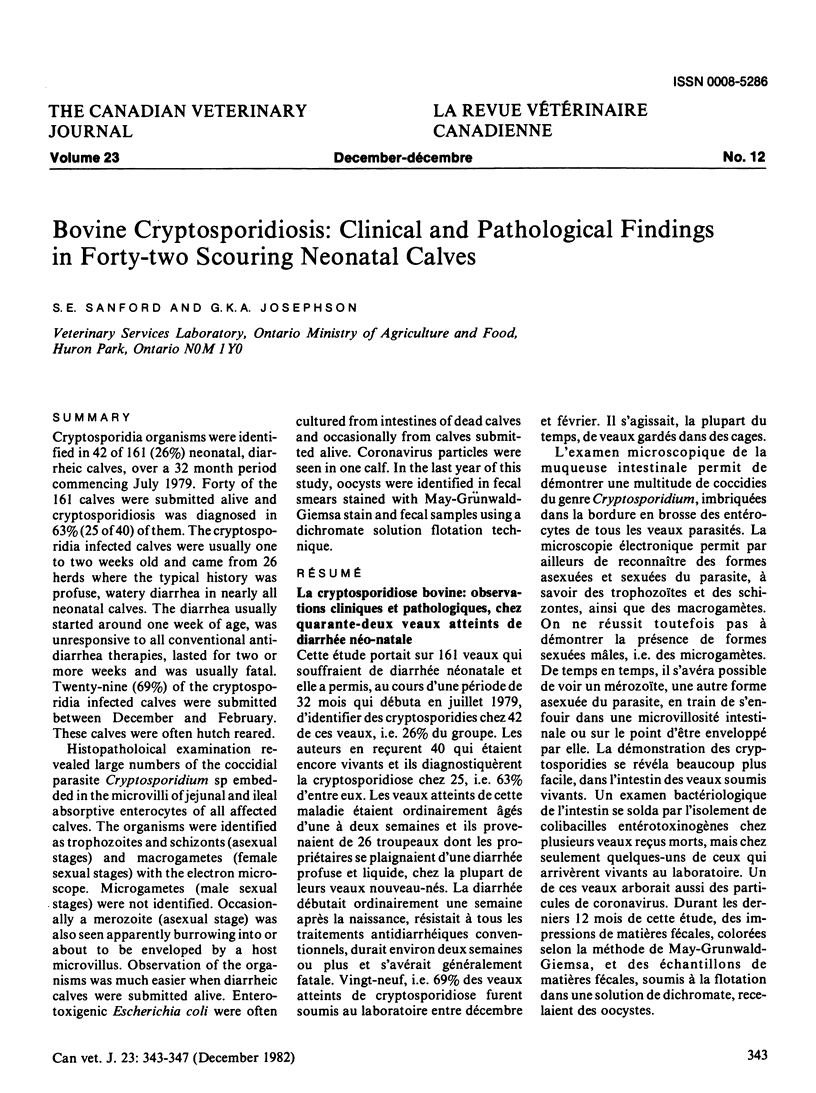
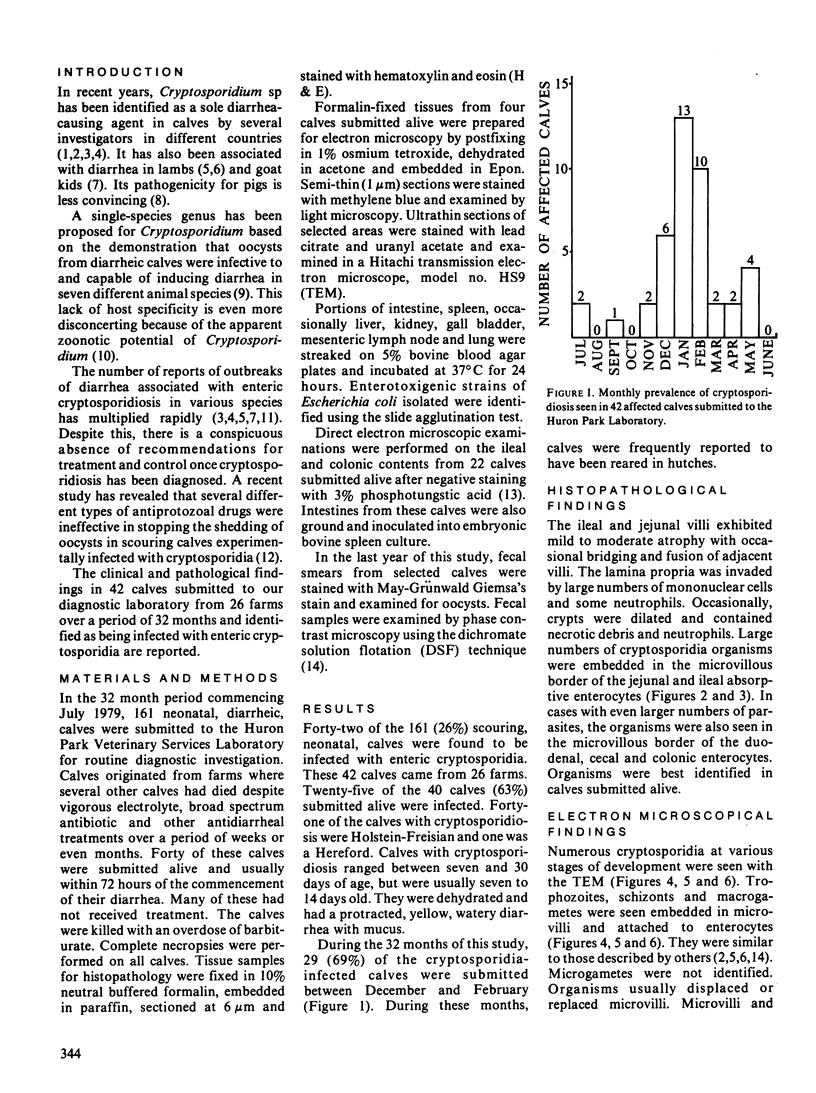
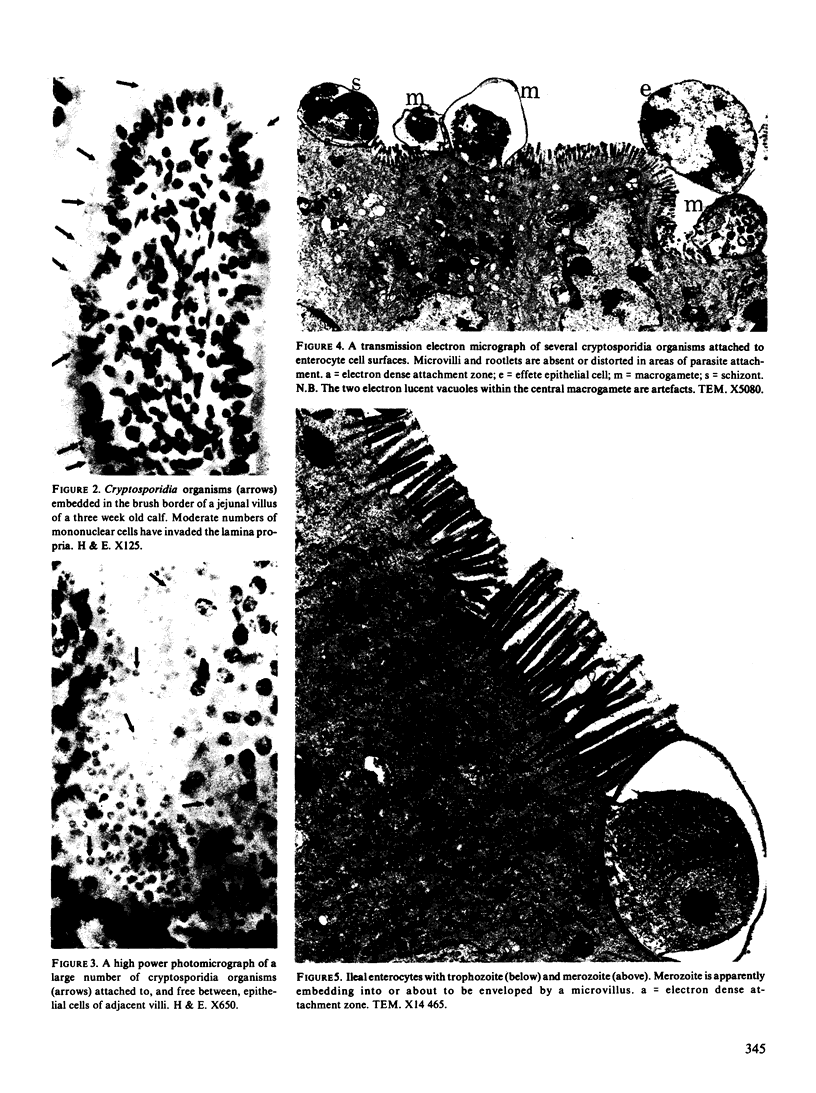
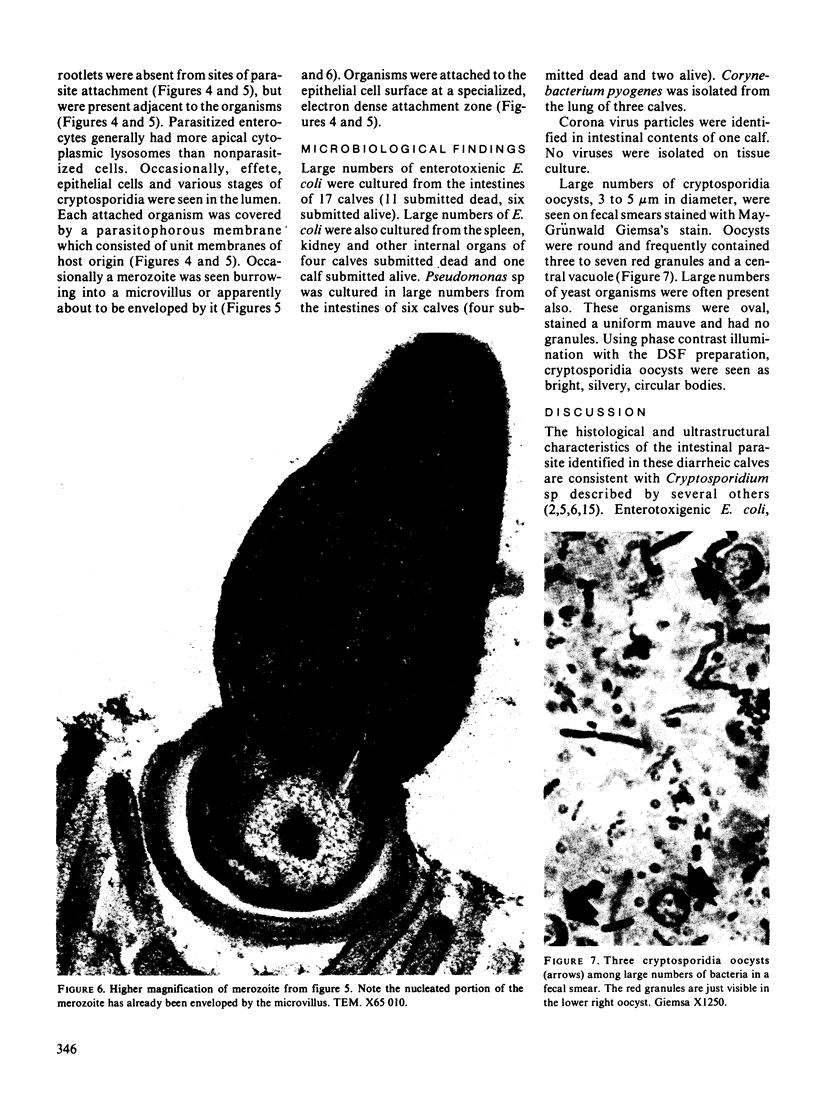
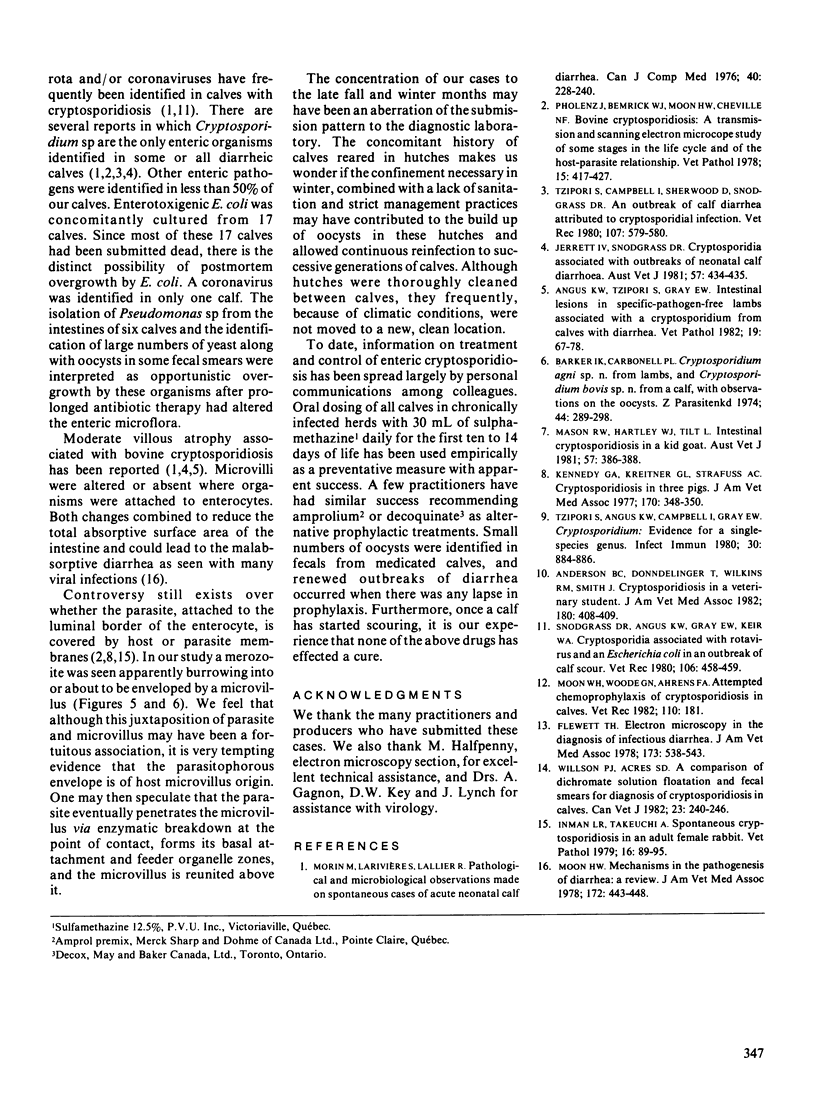
Images in this article
Selected References
These references are in PubMed. This may not be the complete list of references from this article.
- Anderson B. C., Donndelinger T., Wilkins R. M., Smith J. Cryptosporidiosis in a veterinary student. J Am Vet Med Assoc. 1982 Feb 15;180(4):408–409. [PubMed] [Google Scholar]
- Angus K. W., Tzipori S., Gray E. W. Intestinal lesions in specific-pathogen-free lambs associated with a cryptosporidium from calves with diarrhea. Vet Pathol. 1982 Jan;19(1):67–78. doi: 10.1177/030098588201900110. [DOI] [PubMed] [Google Scholar]
- Barker I. K., Carbonell P. L. Cryptosporidium agni sp.n. from lambs, and cryptosporidium bovis sp.n. from a calf, with observations on the oocyst. Z Parasitenkd. 1974;44(4):289–298. doi: 10.1007/BF00366112. [DOI] [PubMed] [Google Scholar]
- Flewett T. H. Electron microscopy in the diagnosis of infectious diarrhea. J Am Vet Med Assoc. 1978 Sep 1;173(5 Pt 2):538–543. [PubMed] [Google Scholar]
- Inman L. R., Takeuchi A. Spontaneous cryptosporidiosis in an adult female rabbit. Vet Pathol. 1979 Jan;16(1):89–95. doi: 10.1177/030098587901600109. [DOI] [PubMed] [Google Scholar]
- Jerrett I. V., Snodgrass D. R. Cryptosporidia associated with outbreaks of neonatal calf diarrhoea. Aust Vet J. 1981 Sep;57(9):434–435. doi: 10.1111/j.1751-0813.1981.tb00560.x. [DOI] [PubMed] [Google Scholar]
- Kennedy G. A., Kreitner G. L., Strafuss A. C. Cryptosporidiosis in three pigs. J Am Vet Med Assoc. 1977 Feb 1;170(3):348–350. [PubMed] [Google Scholar]
- Mason R. W., Hartley W. J., Tilt L. Intestinal cryptosporidiosis in a kid goat. Aust Vet J. 1981 Aug;57(8):386–388. doi: 10.1111/j.1751-0813.1981.tb00529.x. [DOI] [PubMed] [Google Scholar]
- Moon H. W. Mechanisms in the pathogenesis of diarrhea: a review. J Am Vet Med Assoc. 1978 Feb 15;172(4):443–448. [PubMed] [Google Scholar]
- Moon H. W., Woode G. N., Ahrens F. A. Attempted chemoprophylaxis of cryptosporidiosis in calves. Vet Rec. 1982 Feb 20;110(8):181–181. doi: 10.1136/vr.110.8.181-a. [DOI] [PubMed] [Google Scholar]
- Morin M., Larivière S., Lallier R. Pathological and microbiological observations made on spontaneous cases of acute neonatal calf diarrhea. Can J Comp Med. 1976 Jul;40(3):228–240. [PMC free article] [PubMed] [Google Scholar]
- Pohlenz J., Bemrick W. J., Moon H. W., Cheville N. F. Bovine cryptosporidiosis: a transmission and scanning electron microscopic study of some stages in the life cycle and of the host-parasite relationship. Vet Pathol. 1978 May;15(3):417–427. doi: 10.1177/030098587801500318. [DOI] [PubMed] [Google Scholar]
- Snodgrass D. R., Angus K. W., Gray E. W., Keir W. A., Clerihew L. W. Cryptosporidia associated with rotavirus and an Escherichia coli in an outbreak of calf scour. Vet Rec. 1980 May 31;106(22):458–460. doi: 10.1136/vr.106.22.458-a. [DOI] [PubMed] [Google Scholar]
- Tzipori S., Angus K. W., Campbell I., Gray E. W. Cryptosporidium: evidence for a single-species genus. Infect Immun. 1980 Dec;30(3):884–886. doi: 10.1128/iai.30.3.884-886.1980. [DOI] [PMC free article] [PubMed] [Google Scholar]
- Tzipori S., Campbell I., Sherwood D., Snodgrass D. R., Whitelaw A. An outbreak of calf diarrhoea attributed to cryptosporidial infection. Vet Rec. 1980 Dec 20;107(25-26):579–580. [PubMed] [Google Scholar]
- Willson P. J., Acres S. D. A comparison of dichromate solution floatation and fecal smears for diagnosis of cryptosporidiosis in calves. Can Vet J. 1982 Aug;23(8):240–246. [PMC free article] [PubMed] [Google Scholar]



